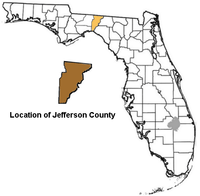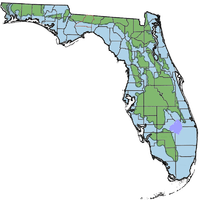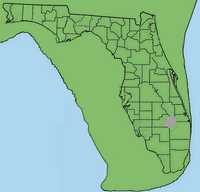Jefferson County, Florida paleontological sites



The Jefferson County, Florida paleontological sites are assemblages of Mid-Miocene to Late Pleistocene vertebrates from Jefferson County, Florida, United States.
Age
Era: Neogene
Period: Miocene to Pleistocene, ~23.03 Mya—11,000 years ago. (calculates to a period of approximately 22.92 million years).
Faunal stage: Clarendonian through early Rancholabrean
Sites
Ashville site (Miocene) Time period: ~13.5—12.7 Mya.[1]
Aucilla River site (Pleistocene) Time period: ~126,000—11,000 years ago. The Aucilla site specimens were discovered by amateur paleontologist Dr. Richard Ohmes of Bremerton, Washington in 1969.[2]
Coordinates: 30°06′N 83°54′W / 30.1°N 83.9°W
Wacissa River site (Pleistocene) Time period: ~126,000—11,000 years ago. Collected by R. Alexon, B. Mathen, R. Gingery in October 1981; in shallow water. Specimens reposited in the Florida Museum of Natural History.[3]
Coordinates: 30°24′N 83°54′W / 30.4°N 83.9°W
Ashland site = ASH. Aucilla River site = ARS. Wacissa River site = WRS.
Reptiles
- Emydidae (turtle) WRS
- Geochelone (tortoise) ARS
- Alligator WRS
Birds
- Grus americana (whooping crane) ARS
Mammals
- Artiodactyla (deer-like) ASH, ARS
- Bison antiquus (bison) WRS
- Calippus proplacidus ASH
- Camelops (camel) ARS
- Equus (horse) ARS, WRS
- Hemiauchenia (camel) WRS
- Hippotherium (horse) ASH
- Megalonyx (ground sloth) ARS
- Mammut (American mastodon) ARS
- Menoceratinae (rhinoceros)
- Tapirus (tapir) ARS
- Odocoileus virginianus (deer-like) WRS
- Palaeolama (llama) WRS
References
- ↑ R. C. Hulbert. 1988. Bulletin of the Florida State Museum, Biological Sciences 33(3)
- ↑ Paleobiology Database Aucilla River collection
- ↑ Authority: S. D. Webb, J. T. Milanich, R. Alexon and J. S. Dunbar. 1984. A Bison antiquus kill site, Wacissa River, Jefferson County, Florida . American Antiquity 49(2):384-392
- Texas A&M Univdersity
- Webb, S.D. 2000. Two cycles of Late Pleistocene sinkhole filling in the middle Aucilla River, Jefferson County, Florida, pp. 142–153, in W. Schmidt, J. Lloyd, and C. Collier (eds), The Wakulla Springs- Woodville Karst Plain Symposium, Florida Geological Survey Special Publication No. 46.